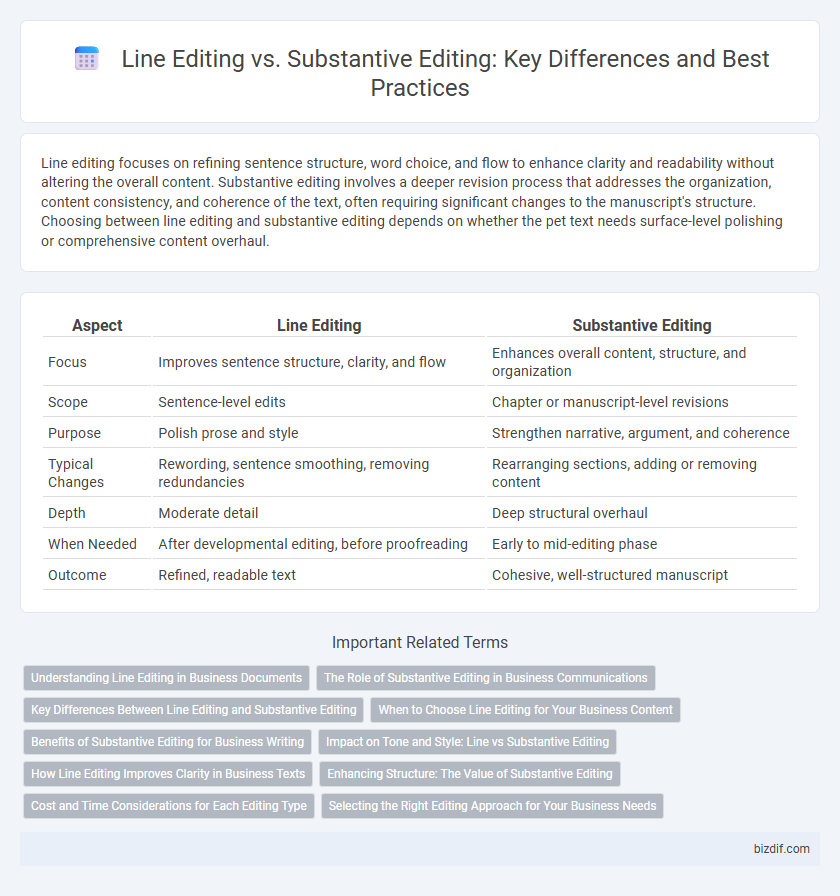Line editing focuses on refining sentence structure, word choice, and flow to enhance clarity and readability without altering the overall content. Substantive editing involves a deeper revision process that addresses the organization, content consistency, and coherence of the text, often requiring significant changes to the manuscript's structure. Choosing between line editing and substantive editing depends on whether the pet text needs surface-level polishing or comprehensive content overhaul.
Table of Comparison
| Aspect | Line Editing | Substantive Editing |
|---|---|---|
| Focus | Improves sentence structure, clarity, and flow | Enhances overall content, structure, and organization |
| Scope | Sentence-level edits | Chapter or manuscript-level revisions |
| Purpose | Polish prose and style | Strengthen narrative, argument, and coherence |
| Typical Changes | Rewording, sentence smoothing, removing redundancies | Rearranging sections, adding or removing content |
| Depth | Moderate detail | Deep structural overhaul |
| When Needed | After developmental editing, before proofreading | Early to mid-editing phase |
| Outcome | Refined, readable text | Cohesive, well-structured manuscript |
Understanding Line Editing in Business Documents
Line editing in business documents focuses on refining sentence structure, clarity, and tone to ensure the message is precise and engaging for the target audience. It involves scrutinizing word choice, syntax, and flow without altering the document's overall content or purpose. This process enhances readability and professionalism, making complex information more accessible to stakeholders.
The Role of Substantive Editing in Business Communications
Substantive editing plays a crucial role in business communications by enhancing the clarity, structure, and overall coherence of content to ensure it effectively conveys the intended message. Unlike line editing, which focuses on grammar, style, and sentence-level improvements, substantive editing addresses larger issues such as content organization, argument flow, and alignment with strategic objectives. This deeper level of editing ensures that business documents not only read well but also support decision-making, branding, and stakeholder engagement.
Key Differences Between Line Editing and Substantive Editing
Line editing focuses on refining sentence structure, word choice, and flow to enhance clarity and style, while substantive editing involves deeper changes to content, organization, and overall narrative coherence. Substantive editing addresses plot inconsistencies, character development, and pacing, whereas line editing targets grammar, syntax, and readability. Both editing types are essential for producing polished, compelling manuscripts but serve distinct purposes in the revision process.
When to Choose Line Editing for Your Business Content
Line editing is ideal for business content that requires polishing language, enhancing clarity, and improving sentence flow without altering the overall structure or message. If your document has a solid foundation but needs refined tone, style consistency, and error-free grammar, line editing ensures professional and engaging communication. Choose line editing when the primary goal is to elevate readability and precision while maintaining the original content intact.
Benefits of Substantive Editing for Business Writing
Substantive editing improves business writing by enhancing clarity, coherence, and overall message flow, ensuring the content effectively communicates key points to targeted audiences. This type of editing identifies and restructures weak arguments, streamlines information, and aligns the tone with corporate branding, increasing reader engagement and professionalism. Businesses benefit from substantive editing through polished documents that support decision-making, strengthen brand reputation, and boost persuasive impact.
Impact on Tone and Style: Line vs Substantive Editing
Line editing sharpens the clarity and flow of sentences, enhancing the author's voice and refining style for immediate reader engagement. Substantive editing restructures content at a macro level, fundamentally altering tone and narrative to better align with the intended audience and purpose. Together, these editing types ensure both the precision of language and the effectiveness of overall communication.
How Line Editing Improves Clarity in Business Texts
Line editing enhances clarity in business texts by refining sentence structure, word choice, and tone to ensure messages are concise and easily understood. It eliminates redundancy and awkward phrasing, improving overall readability and flow. By focusing on clarity at the sentence level, line editing makes complex business concepts more accessible and impactful for the target audience.
Enhancing Structure: The Value of Substantive Editing
Substantive editing enhances structure by reorganizing content for clarity and logical flow, improving paragraph coherence and overall narrative development. It addresses large-scale issues such as plot consistency, character development, and thematic emphasis, which line editing does not typically cover. This deep-level refinement ensures that the manuscript resonates meaningfully with readers and maintains engagement throughout.
Cost and Time Considerations for Each Editing Type
Line editing generally incurs lower costs and requires less time than substantive editing due to its focus on sentence structure, grammar, and style. Substantive editing involves in-depth content revisions, making it more expensive and time-consuming as it addresses plot, organization, and overall manuscript coherence. Authors should weigh budget constraints and deadlines carefully when choosing between line editing and substantive editing services.
Selecting the Right Editing Approach for Your Business Needs
Selecting the right editing approach depends on your business goals and content quality; line editing enhances clarity, flow, and style by refining sentence structure and word choice, while substantive editing involves deeper changes to organization, content accuracy, and overall coherence. For businesses aiming to improve readability and polish existing text, line editing provides targeted linguistic improvements without altering core ideas. When the content requires major revisions to structure, facts, or messaging, substantive editing addresses these issues to align the material with strategic objectives.
Line editing vs substantive editing Infographic

 bizdif.com
bizdif.com